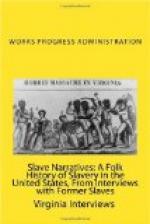At this time marriages resulted from brief courtships. After the consent of the girl was obtained, it was necessary to seek permission from the master, whether she lived on the same or an adjoining plantation. In the latter case, the marriage rites were performed by her master. The minister was not used in most instances—the ceremony [HW: being] read from a testament by the owner of the bride. Marriages were nearly always performed out of doors in the late afternoon. The bride’s wedding dress was fashioned of cloth made on the plantation from a pattern of her own designing. Attendants at marriages were rare. After the ceremony, the guests danced far into the night by music from the fiddle and banjo. Refreshments consisting of ginger cakes, barbecue, etc., were served. Such a couple, belonging to two different masters, did not keep house. The [HW: husband] was allowed to visit his wife on Wednesday night and Saturday when he might remain through Sunday. All marriage unions were permanent and a barren wife was considered the only real cause for separation.
Church services for this group were held jointly with the white members, the two audiences being separated by a partition. Gradually, the colored members became dissatisfied with this type of service and withdrew to form a separate church. The desire for independence in worship must necessarily have been strong, to endure the inconveniences of the “brush arbor” churches that they resorted to. As a beginning, several trees were felled, and the brush and forked branches separated. Four heavy branches with forks formed the framework. Straight poles were laid across these to form a crude imitation of beams and the other framework of a building. The top and sides were formed of brush which was thickly placed so that it formed a solid wall. A hole left in one side formed a doorway from which beaten paths extended in all directions. Seats made from slabs obtained at local sawmills completed the furnishing. In inclement weather, it was not possible to conduct services here, but occasionally showers came in the midst of the service and the audience calmly hoisted umbrellas or papers and with such scant protection, the worship continued.
Sunday afternoons were quietly spent, visiting being the only means of recreation. One of the favorite stay at home pastimes was the inspection of heads. The pediculous condition made frequent treatment necessary for comfort. The young white men liked to visit the “quarters” and have the slaves search their heads. They would stretch full length upon the cabin floors and rest their heads upon a pillow. Usually they offered a gift of some sort if many of the tiny parasites were destroyed, so the clever picker who found a barren head simply reached into his own and produced a goodly number. There existed on this plantation an antagonistic feeling toward children (born of slave parents) with a beautiful suit of hair, and this type of hair was kept cropped very short.




